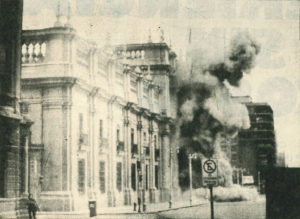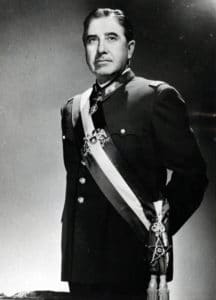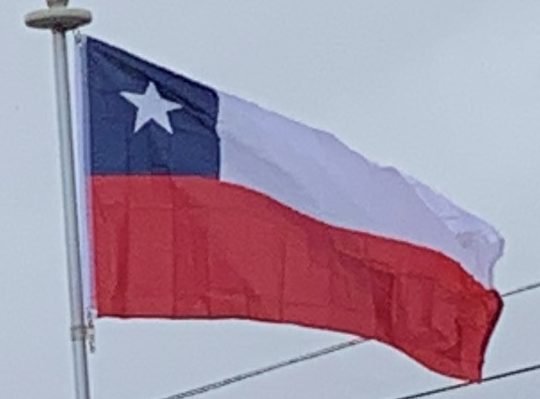An economic depression that began in 1972 was exacerbated by capital flight, plummeting private investment, and withdrawal of bank deposits in response to Allende’s socialist program. Production fell and unemployment rose. Allende adopted measures including price freezes, wage increases, and tax reforms, to increase consumer spending and redistribute income downward. Joint public-private public works projects helped reduce unemployment. Much of the banking sector was nationalized. Many enterprises within the copper, coal, iron, nitrate, and steel industries were expropriated, nationalized, or subjected to state intervention. Industrial output increased sharply and unemployment fell during the Allende administration’s first year.
Allende’s program included advancement of workers’ interests, replacing the judicial system with “socialist legality”, nationalization of banks and forcing others to bankruptcy, and strengthening “popular militias” known as MIR. Started under former President Frei, the Popular Unity platform also called for nationalization of Chile’s major copper mines in the form of a constitutional amendment. The measure was passed unanimously by Congress.
As a result, the Richard Nixon administration organized and inserted secret operatives in Chile, in order to swiftly destabilize Allende’s government. In addition, US financial pressure restricted international economic credit to Chile.
The economic problems were also exacerbated by Allende’s public spending which was financed mostly by printing money and poor credit ratings given by commercial banks. Simultaneously, opposition media, politicians, business guilds and other organizations helped to accelerate a campaign of domestic political and economical destabilization, some of which was backed by the United States. By early 1973, inflation was out of control. The crippled economy was further battered by prolonged and sometimes simultaneous strikes by physicians, teachers, students, truck owners, copper workers, and the small business class. On 26 May 1973, Chile’s Supreme Court, which was opposed to Allende’s government, unanimously denounced the Allende disruption of the legality of the nation. Although illegal under the Chilean constitution, the court supported and strengthened Pinochet’s soon-to-be seizure of power.
Pinochet era (1973–1990):
A military coup overthrew Allende on 11 September 1973. As the armed forces bombarded the presidential palace, Allende apparently committed suicide. After the coup, Henry Kissinger told U.S. president Richard Nixon that the United States had “helped” the coup.

A military junta, led by General Augusto Pinochet, took control of the country. The first years of the regime were marked by human rights violations. Chile actively participated in Operation Condor. On October 1973, at least 72 people were murdered by the Caravan of Death. According to the Rettig Report and Valech Commission, at least 2,115 were killed, and at least 27,265 were tortured (including 88 children younger than 12 years old). In 2011, Chile recognized an additional 9,800 victims, bringing the total number of killed, tortured or imprisoned for political reasons to 40,018.

A new Constitution was approved by a controversial plebiscite on 11 September 1980, and General Pinochet became president of the republic for an eight-year term. In the late 1980s, largely as a result of events such as the 1982 economic collapse and mass civil resistance in 1983–88, the government gradually permitted greater freedom of assembly, speech, and association, to include trade union and political activity. The government launched market-oriented reforms with Hernán Büchi as Minister of Finance. Chile moved toward a free market economy that saw an increase in domestic and foreign private investment, although the copper industry and other important mineral resources were not opened for competition. In a plebiscite on 5 October 1988, Pinochet was denied a second eight-year term as president (56% against 44%). Chileans elected a new president and the majority of members of a bicameral congress on 14 December 1989. Christian Democrat Patricio Aylwin, the candidate of a coalition of 17 political parties called the Concertación, received an absolute majority of votes (55%). President Aylwin served from 1990 to 1994, in what was considered a transition period.
21st Century:
In December 1993, Christian Democrat Eduardo Frei Ruiz-Tagle, the son of previous president Eduardo Frei Montalva, led the Concertación coalition to victory with an absolute majority of votes (58%). Frei Ruiz-Tagle was succeeded in 2000 by Socialist Ricardo Lagos, who won the presidency in an unprecedented runoff election against Joaquín Lavín of the rightist Alliance for Chile. In January 2006, Chileans elected their first female president, Michelle Bachelet Jeria, of the Socialist Party, defeating Sebastián Piñera, of the National Renewal party, extending the Concertación governance for another four years. In January 2010, Chileans elected Sebastián Piñera as the first rightist President in 20 years, defeating former President Eduardo Frei Ruiz-Tagle of the Concertación, for a four-year term succeeding Bachelet. Due to term limits, Sebastián Piñera did not stand for re-election in 2013, and his term expired in March 2014 resulting in Michelle Bachelet returning to office.
